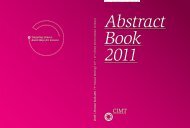Abstract Book 2010 - CIMT Annual Meeting
Abstract Book 2010 - CIMT Annual Meeting
Abstract Book 2010 - CIMT Annual Meeting
Create successful ePaper yourself
Turn your PDF publications into a flip-book with our unique Google optimized e-Paper software.
072 van Esch | New targets & new leads<br />
T cell epitope discovery through HLA class I peptide ligand exchange<br />
and combinatorial coding<br />
Wim van Esch 1 , Juk Yee Mok 1 , Annemieke Molenaar 1 , Arnold Bakker 2 , Mireille Toebes 2 ,<br />
Sine Reker Hadrup 2 , Chengyi Shu 2 , Ernst Soethout 3 , Josine van Beek 3 , Huib Ovaa 4 and Ton<br />
Schumacher 2<br />
1 Dept. R&D, Sanquin Reagents, Amsterdam, The Netherlands<br />
2 Div. Immunology, The Netherlands Cancer Institute, Amsterdam, The Netherlands<br />
3 Netherlands Vaccine Institute, Bilthoven, The Netherlands<br />
4 Div. Cellular Biochemistry, The Netherlands Cancer Institute, Amsterdam, The Netherlands<br />
Human major histocompatibility complex class I<br />
(HLA-I) consists of beta2-microglobulin, a polymorphic<br />
heavy chain and a peptide ligand. Peptides<br />
in context with HLA-I on the cell surface are<br />
recognized by appropriate cytotoxic T cells. Our<br />
aim is to develop a platform for high-throughput<br />
identification of HLA-I ligands and T cell detection<br />
using flow cytometry in order to detect new<br />
disease-specific epitopes/T cells. To this end, conditional<br />
ligands that can be cleaved in the HLAbound<br />
state upon UV irradiation were designed<br />
for different HLA alleles. Cleavage of HLA-I-bound<br />
conditional ligand in the presence of another experimental<br />
ligand results in peptide exchange.<br />
Only those peptides that fit in the peptide binding<br />
groove will be able to maintain the integrity of the<br />
empty HLA complex, and the efficiency of HLA-I<br />
stabilization by experimental ligands can be determined<br />
by ELISA. Subsequently, HLA-I-binding<br />
peptides identified in this manner are tested for<br />
their immunological relevance. To this purpose, a<br />
combinatorial coding technology has been developed<br />
that allows the parallel detection of a multitude<br />
of different T cell populations in a single sample.<br />
Detection of antigen-specific T cells from peripheral<br />
blood by combinatorial coding is as efficient<br />
as detection with conventionally fluorescently-labeled<br />
HLA multimers and allows comprehensive<br />
screens to be performed. Using these technologies,<br />
several screens for HLA ligands have been performed,<br />
either manually or using robotics, using<br />
peptides potentially associated with infectious or<br />
non-infectious diseases. Large-scale screenings of<br />
their immunological relevance by analysis of T cell<br />
responses using combinatorial coding are ongoing.<br />
Together these techniques form a highly efficient<br />
platform for T cell epitope discovery in a broad<br />
range of human diseases and for the monitoring of<br />
disease- and therapy-induced T cell immunity.<br />
117



